Overview
In today’s fast-paced world, crafting an effective entrepreneur elevator pitch can feel daunting, especially during networking events or job transitions. We understand that these moments can be filled with anxiety and uncertainty. However, having a well-prepared pitch is not just about delivering information; it’s about making meaningful connections that can open doors to new opportunities.
An impactful pitch includes essential components:
- A clear introduction that captures attention
- A unique selling proposition that highlights what sets you apart
- A compelling call to action that encourages further engagement
Research shows that those who invest time in preparing their pitch significantly enhance their professional opportunities and connections, particularly in a competitive job market.
You are not alone in feeling overwhelmed by the idea of pitching yourself. Many share this struggle, but remember, every successful entrepreneur started where you are now. Embrace the journey and allow your passion and purpose to shine through your pitch. By focusing on your unique strengths and experiences, you can convey your value with confidence.
Take a moment to reflect:
- What makes you unique?
- How can your experiences resonate with others?
These questions can guide you in crafting a pitch that not only informs but also inspires. As you prepare, consider the emotional impact your words can have on your audience; storytelling can be a powerful tool in this regard.
Ultimately, remember that every opportunity begins with a single conversation. By taking the time to develop your elevator pitch, you are investing in your future and taking ownership of your career. Let’s embark on this journey together, and you will find that with practice and perseverance, you can master the art of the elevator pitch.
Introduction
In today’s job market, where competition is fierce, many individuals face the daunting task of transitioning careers. We understand that this journey can be overwhelming, filled with uncertainty and self-doubt. However, the ability to deliver a compelling elevator pitch can truly be a game-changer, offering you a chance to express your unique value and aspirations in just 30 to 60 seconds. This brief yet impactful tool serves not only to enhance your networking opportunities but also to pave the way for meaningful connections that may lead to exciting new professional avenues.
As you navigate the complexities of shifting careers, it’s essential to master this art. With expert insights and practical strategies, we will explore the key elements of crafting an effective elevator pitch tailored to different audiences and situations. Whether you are looking to redefine your career path or simply wish to leave a lasting impression, understanding the nuances of a well-crafted pitch is vital for your success in today’s dynamic economy. Remember, you are not alone in this journey, and with the right guidance, you can take ownership of your career and embrace the opportunities that lie ahead.
Understanding the Elevator Pitch: What It Is and Why It Matters
A brief and engaging entrepreneur elevator pitch is designed to spark interest in you or your organization. Typically lasting between 30 to 60 seconds, it should be concise enough to convey during a brief lift ride. The primary goal of an entrepreneur elevator pitch is to clearly and effectively communicate your value proposition, making it an essential tool for networking, job interviews, and business introductions.
In the context of job changes, the importance of a well-prepared self-introduction cannot be overstated. Have you ever felt the pressure of making a lasting impression? According to recent studies, individuals who deliver a compelling introduction during networking events significantly enhance their chances of forming valuable connections. This statistic highlights the necessity of mastering this skill, especially for those navigating career changes in a challenging economy where employability issues are prevalent.
Experts emphasize that a compelling entrepreneur elevator pitch not only showcases your professional identity but also reflects your adaptability and readiness for new opportunities. Parnell Woodard, a Career Ownership Coach at Find Your Career 2.0, underscores this notion by stating, “The Entrepreneur’s Source focuses on providing Career Ownership Coaching™ to individuals seeking to explore new professional opportunities.” This perspective reinforces the idea that a well-crafted entrepreneur elevator pitch can set you apart in competitive job markets, particularly when transitioning from traditional employment to business ownership, ultimately leading to greater financial independence and stability.
Consider this: candidates who effectively express their skills and experiences through a brief presentation often leave a lasting impression on potential employers. For instance, individuals who emphasize their commitment to lifelong education and advanced degrees during networking events have been shown to significantly enhance their job prospects. This demonstrates that an entrepreneur elevator pitch can be a powerful asset in advancing one’s career, especially when striving for financial freedom and personal agency in a changing job market.
When presenting a brief overview, especially in online discussions, it’s essential to maintain a professional appearance. Are you ensuring appropriate camera angles, good lighting, and minimizing distractions? This practical advice can greatly enhance the effectiveness of your presentation.
Additionally, Find Your Career 2.0 offers free consultations to individuals seeking ownership of their profession. This service provides essential support for those looking to refine their entrepreneur elevator pitch and successfully navigate their professional transitions. Such guidance is invaluable for those facing the emotional and practical challenges of income growth as they strive to mitigate risks and accelerate their new pathways.
To further assist in your professional transition, we invite you to download your free Veteran Entrepreneur® Program presentation here. This resource offers insights and techniques for perfecting your presentation and achieving your professional objectives.
In summary, understanding what an entrepreneur elevator pitch is and its significance in job transitions is essential for anyone looking to make a strong impression in professional settings. By honing this skill, you can effectively navigate the complexities of job transitions and position yourself for success. Additionally, consider exploring ‘Your Career 2.0: A Survival Guide for The Battered Career Syndrome® and Investor Syndrome®’ for more comprehensive strategies on taking control of your professional path.
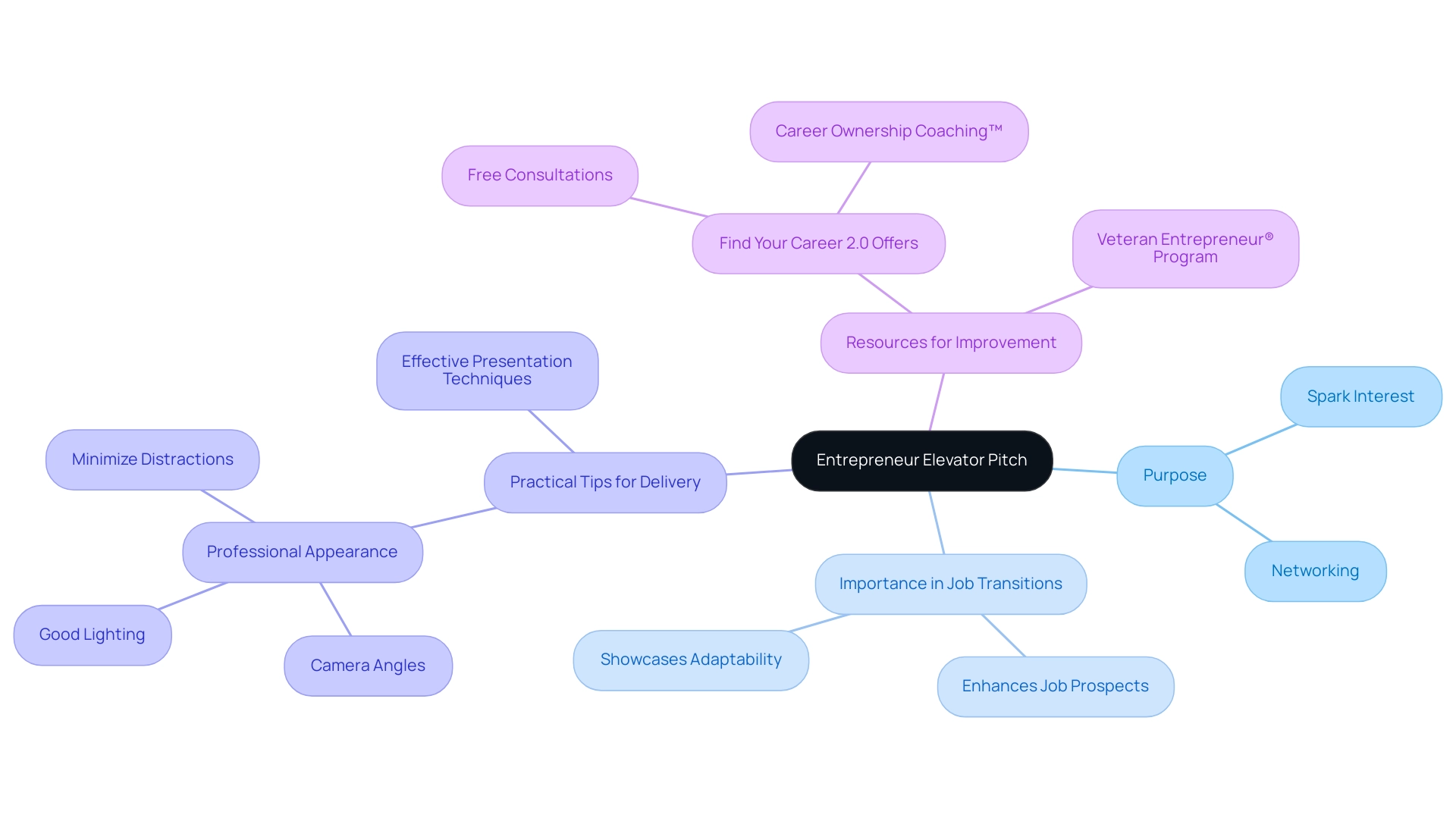
Essential Elements of a Compelling Elevator Pitch
A compelling elevator pitch serves as a powerful tool for entrepreneurs, and it encompasses several essential components that can truly resonate with your audience:
- Introduction: Start by sharing your name along with a brief background that establishes your credibility. This personal touch sets the stage for a genuine connection with your audience, making them feel valued.
- What You Do: Clearly express your current role or the passion that drives you. This clarity helps your audience understand your professional identity and the unique value you bring, especially as you navigate the challenges of job transitions in a shifting job market.
- Unique Selling Proposition (USP): Here’s where you shine a light on what sets you apart from others in your field. A strong USP is vital; it should resonate with your audience and leave a lasting impression. For instance, Find Your Profession 2.0 emphasizes its comprehensive and personalized approach to coaching, establishing itself as a trusted partner for individuals seeking to reinvent their professional lives. The company has successfully assisted hundreds of thousands in evaluating their job possibilities, underscoring its credibility and experience. This is particularly relevant for those aspiring to achieve financial freedom and personal agency through business ownership or other career pathways.
- Call to Action: Conclude with a specific request or suggestion for further conversation. This might be an invitation to connect on LinkedIn, schedule a follow-up meeting, or explore collaboration opportunities. Additionally, consider providing guidance on creating, customizing, and sharing digital business cards to foster genuine connections without paper. Don’t forget to download your free Veteran Entrepreneur® Program presentation here.
As you craft your pitch, consider these strategies:
- Customization: Tailor your pitch to your audience. Understanding their needs and interests can significantly enhance engagement, especially when addressing employability challenges and aspirations for financial independence.
- Clarity and Brevity: Aim for a presentation that is concise yet informative. Research indicates that clear and focused presentations are more effective in professional networking, particularly in today’s fast-paced career economy.
- Practice: Rehearse your presentation to ensure smooth delivery. As Brad, a co-author, wisely puts it, “I don’t want to hear you describe what you are going to do, I want to see it.”
In 2025, statistics reveal that presentations incorporating these elements are significantly more effective in networking scenarios, leading to increased opportunities for collaboration and partnership. By organizing your brief presentation around these elements, you can create a memorable and impactful introduction that resonates with your audience, reflecting the transformative journey outlined in Your Journey 2.0: A Survival Guide for navigating Battered Profession Syndrome and Investor Syndrome.
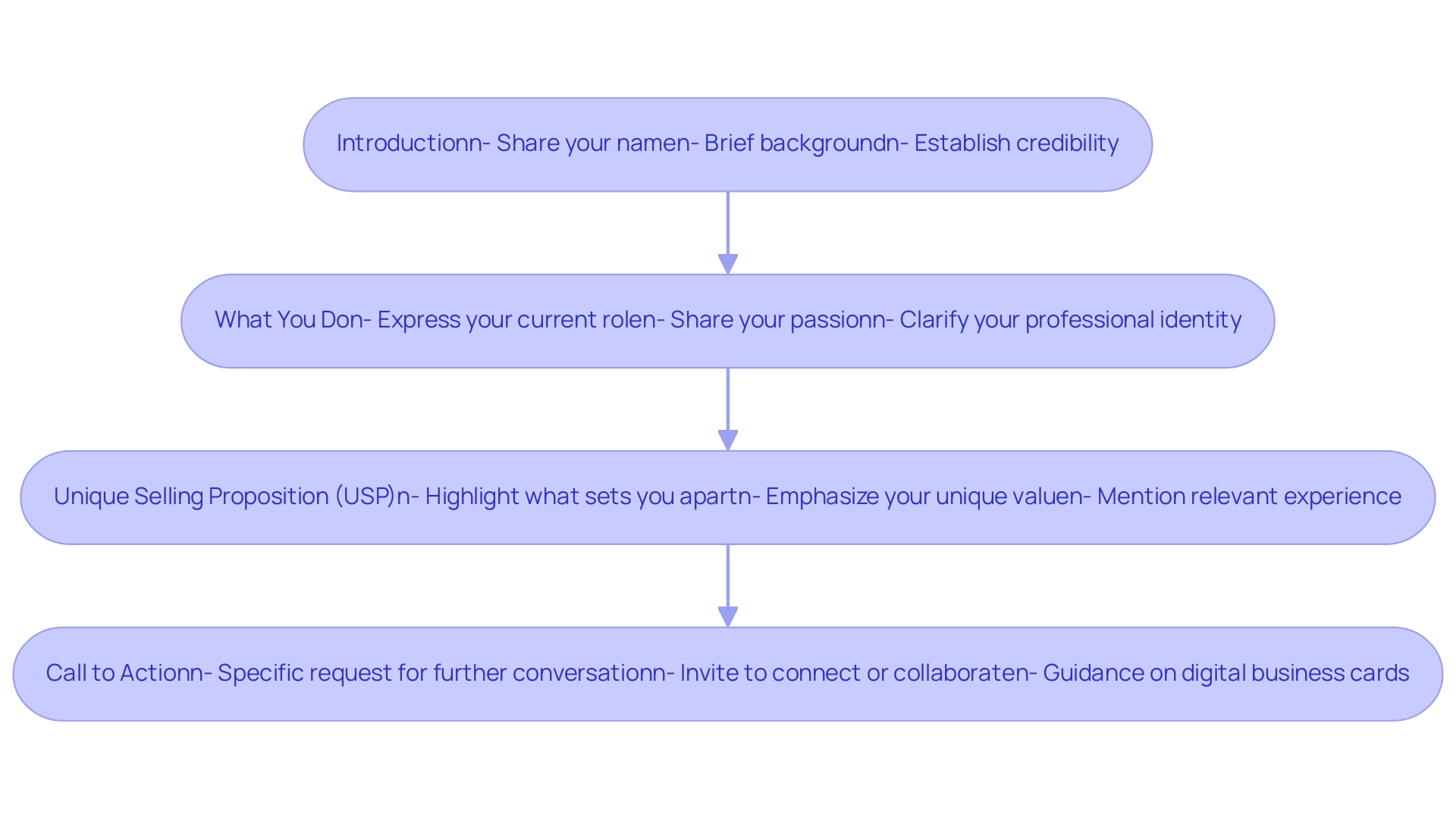
Tailoring Your Elevator Pitch for Career Transitioners
When creating an entrepreneur elevator pitch for a job transition, it’s vital to embrace a strategic approach that truly resonates with potential employers. As Parnell Woodard, an Ownership Coach at Find Your Career 2.0, emphasizes, “Find Your Career 2.0 concentrates on offering Ownership Coaching™ to individuals looking to explore new professional opportunities.” Here are some key strategies to consider:
-
Acknowledge Your Transition: Start by briefly mentioning your previous role and the motivation behind your job change. This sets the context and highlights your awareness of the evolving job landscape, especially as 55% of LinkedIn members may experience job changes due to advancements like generative AI. Acknowledging the urgency in professional advancement is essential, as emphasized in ‘Your Career Revolution’ chapters.
-
Highlight Transferable Skills: Emphasize the skills and experiences that are most relevant to your new professional journey. In 2025, employers increasingly value adaptability, problem-solving, and communication skills. For instance, a recent study reveals that employees aged 23-34 have held an average of 4.5 jobs, reflecting a trend towards exploring diverse roles early in their careers. This underscores the importance of showcasing how your varied experiences contribute to your new direction, especially in a declining career economy where transferable skills can mitigate risks and fast-track your new career.
-
Express Enthusiasm: Share genuine excitement about the new opportunities that await you and how they align with your passions. This enthusiasm can be contagious, creating a positive impression and reinforcing your commitment to financial freedom and lifestyle fulfillment.
-
Connect the Dots: Clearly articulate how your past experiences can benefit your new role or industry. For example, if you have a background in project management, highlight how those skills can translate into effective leadership in a new sector. This connection not only showcases your adaptability but also your readiness to embrace change in a dynamic job market.
-
Practice and Seek Feedback: Regular practice and seeking input can significantly enhance the effectiveness of your presentation. Engaging your audience with a genuine compliment or question before concluding your presentation can further strengthen your connection, along with a clear call to action that invites further discussion.
Incorporating these elements not only helps you stand out but also reassures potential employers of your adaptability and readiness for change. By tailoring your entrepreneur elevator pitch to highlight your unique journey and the transferable skills you possess, you position yourself as a compelling candidate in today’s dynamic job market, prepared to take control of your destiny and explore new opportunities. For additional resources, consider downloading the “Why work with Parnell” PDF to further assist you in your career transition.
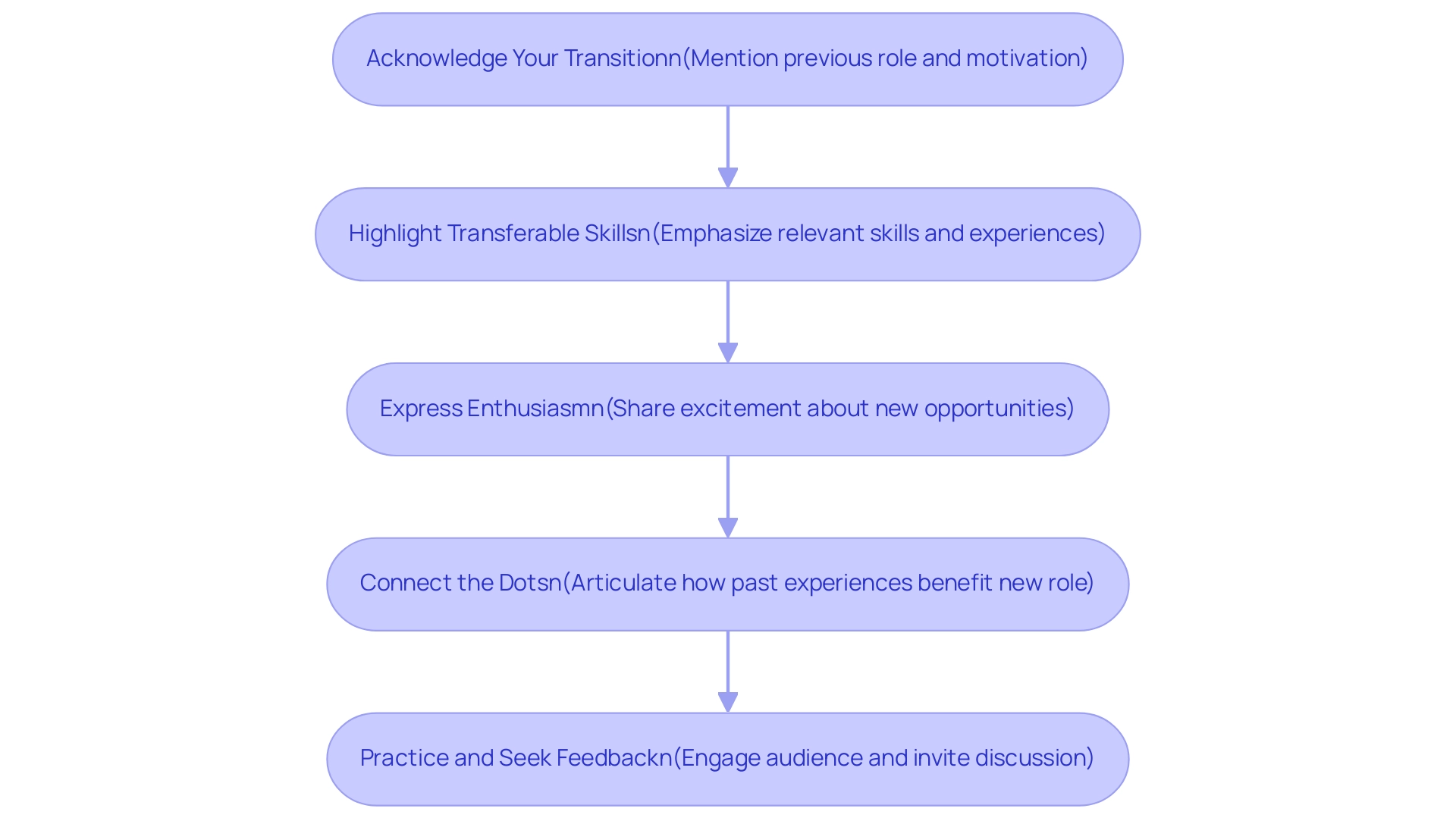
Mastering Delivery: Tips for Presenting Your Elevator Pitch
To master the delivery of your elevator pitch, it’s important to embrace a few supportive strategies:
-
Practice: Rehearse your presentation until it feels second nature. Practicing in front of a mirror or recording yourself can provide valuable feedback and help you refine your delivery. Julia Martins wisely advises, ‘To prepare for unexpected elevator presentations, have a basic outline ready that you can adapt on the spot.’ This preparation is essential, especially in today’s uncertain economic landscape where adaptability is key to navigating employability challenges.
-
Body Language: Your body language plays a crucial role in how your message is received. Maintain an open posture, stand tall, and make consistent eye contact. Use purposeful gestures to emphasize key points, as effective body language can significantly enhance your pitch’s impact. Research indicates that effective body language can improve audience retention of your message by up to 55%. Remember, your confidence and presence can inspire others to see the possibilities in their own professional transitions.
-
Tone and Pace: Clarity is key. Speak clearly and maintain a moderate pace to ensure your audience can absorb your message. Rushing can convey nervousness and detract from your credibility. In a world where jobs are increasingly short-lived, presenting yourself with confidence can help mitigate risks and fast-track your new career.
-
Engage Your Audience: Transform your presentation into a conversation by asking questions or inviting feedback. This interactive method not only makes your presentation more engaging but also fosters a connection with your audience. Engaging others can help you discover new possibilities beyond your current experiences, which is essential for personal empowerment.
Developing a compelling brief presentation involves several key steps: introducing yourself, presenting a problem, offering a solution, explaining your value proposition, and engaging the audience. By following these steps, you can create a persuasive summary that connects with your audience, ultimately enhancing your chances of success in professional interactions. Research indicates that practicing the entrepreneur elevator pitch can lead to a 30% increase in confidence among job seekers, highlighting the importance of preparation.
As you navigate your professional transition, consider downloading the free Veteran Entrepreneur® Program presentation here to further empower yourself in assessing your possibilities and achieving financial independence. By concentrating on these delivery aspects, you can ensure that your presentation resonates with your audience and leaves a lasting impression. The Entrepreneur’s Source’s personalized approach to career coaching can further empower you in this journey, as they have assisted hundreds of thousands of people in assessing their career possibilities and achieving financial independence.
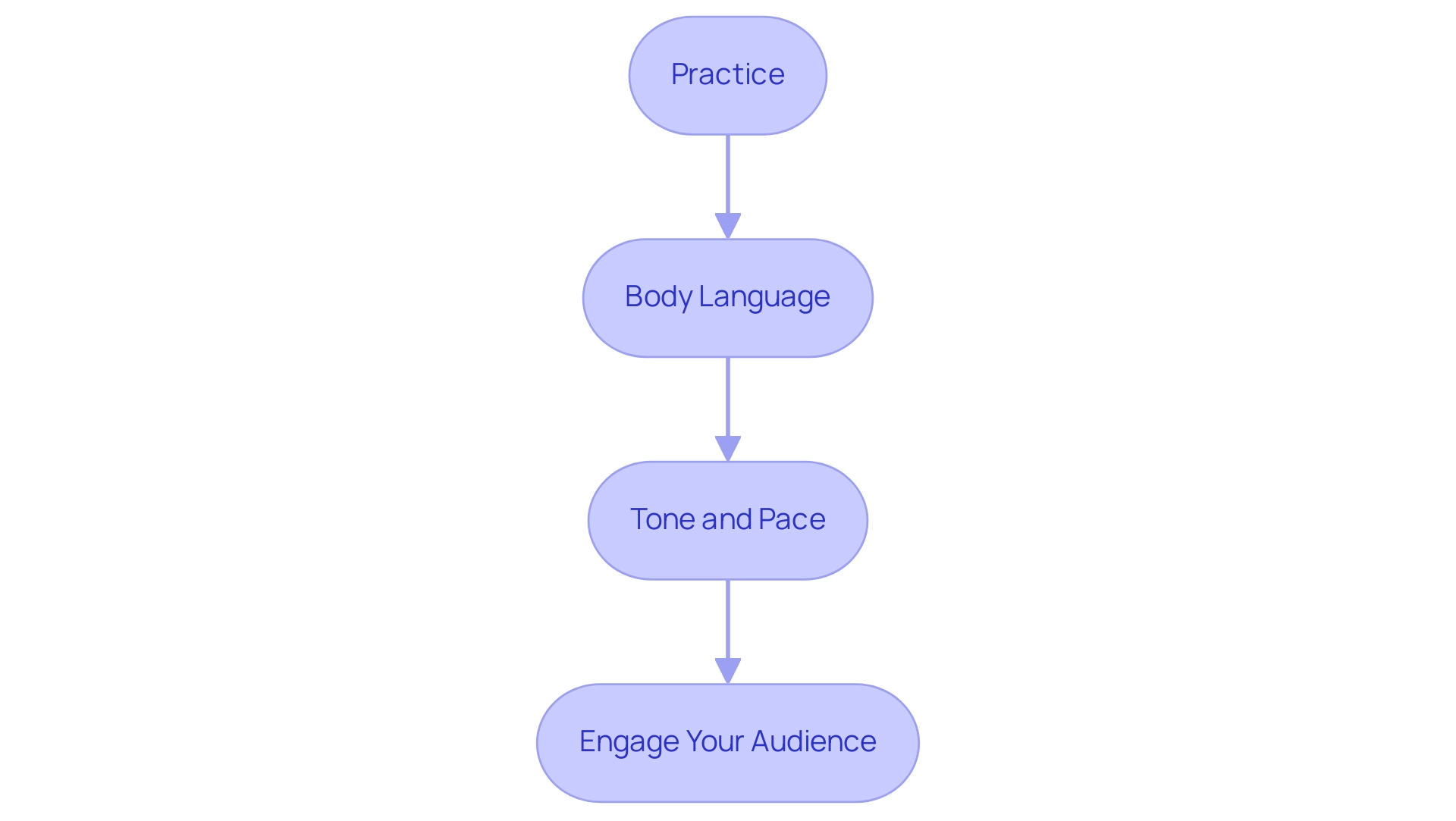
The Importance of Practice: Refining Your Elevator Pitch
Practicing your elevator pitch is essential for several compelling reasons:
-
Builds Confidence: Engaging in regular practice can significantly boost your comfort level when presenting your ideas. We understand that presenting can be daunting, but research indicates that individuals who practice their presentations experience a marked increase in delivery success rates. Tailoring your message to specific industries and roles is a critical component of an effective entrepreneur elevator pitch, enhancing your overall effectiveness. This is particularly vital in today’s declining job market, where traditional employment options are limited. The ability to articulate your value proposition can truly set you apart.
-
Identifies Weaknesses: Consistent practice enables you to uncover specific areas needing improvement, such as clarity, pacing, or audience engagement. This self-evaluation is essential for honing your message and ensuring it connects with audiences, particularly as you navigate the intricacies of professional transitions. Remember, identifying these weaknesses is a step toward growth, and you are not alone in this journey.
-
Encourages Feedback: Sharing your proposal with trusted friends or mentors and soliciting constructive criticism can yield invaluable insights. Feedback is a critical component in the refinement process, allowing you to adjust your approach based on real-world reactions and suggestions. This ultimately empowers you to take control of your career trajectory, reinforcing that you have the support you need.
-
Adapts to Different Audiences: Practicing your presentation equips you to tailor your message for various contexts and audiences. This adaptability ensures that your entrepreneur elevator pitch remains relevant and impactful, regardless of your audience. It’s essential for entrepreneurs aiming to create the lifestyle of their dreams and achieve financial freedom.
Incorporating practice into your preparation not only enhances your ability to communicate effectively but also instills the confidence needed to navigate any professional situation successfully. As highlighted in the case study of Ashley Coker Cranney, a Sport and Performance Consultant, embracing the process of practice fosters psychological flexibility. This allows individuals to view challenges as opportunities for growth rather than obstacles to avoid. Coker Cranney emphasizes, “I help athletes shift their relationships with success, failure, fear, and change,” which resonates deeply with entrepreneurs seeking to make a lasting impression.
Additionally, students can redirect time saved in pitch preparation towards other job preparation activities, enhancing their overall employability and reinforcing their agency in a changing economy. This mindset is crucial for entrepreneurs aiming to reinvent their professional lives. For further guidance, consider exploring ‘Your Career 2.0: A Survival Guide for The Battered Career Syndrome and Investor Syndrome’ and the veteran entrepreneur® program for additional resources tailored to career transitioners.
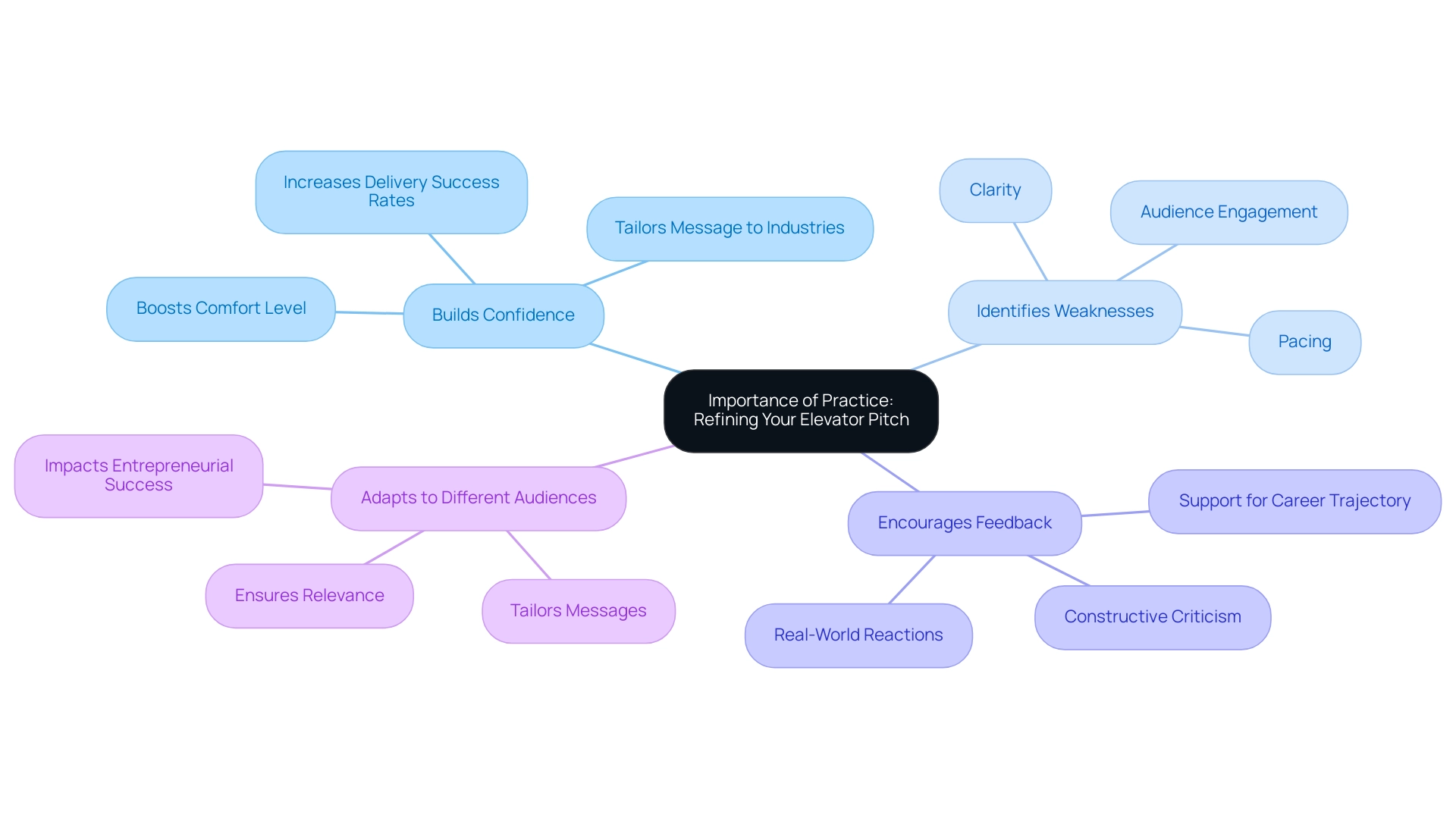
Conclusion
Mastering the art of the elevator pitch is not just a skill; it’s a lifeline for anyone navigating the often-challenging waters of a career transition. We understand how daunting this process can feel. By grasping the essence of an elevator pitch and recognizing its importance, you can communicate your unique value in a clear and concise way. A compelling pitch includes:
- A strong introduction
- A clear explanation of what you do
- A distinctive unique selling proposition
- A well-crafted call to action
These elements not only establish your credibility but also enhance your chances of forging meaningful connections in a competitive job market.
As you embark on this journey, it’s vital to acknowledge your past experiences while showcasing your transferable skills. This approach can significantly boost your appeal to potential employers. Expressing genuine enthusiasm for new opportunities and linking your previous experiences to future roles can further solidify your readiness for change.
Remember, practicing your delivery, refining your body language, and engaging your audience are critical steps that can transform a standard pitch into a memorable conversation starter.
Ultimately, the journey of career transition can be daunting, but with a well-crafted and practiced elevator pitch, you can position yourself as a compelling candidate ready to embrace new opportunities. This skill not only opens doors to networking possibilities but also empowers you to take control of your career trajectory. By investing time in developing and refining this essential tool, you can navigate the complexities of career changes with confidence and clarity, paving the way for a successful professional future. You are not alone in this endeavor; we’re here to support you every step of the way.
Frequently Asked Questions
What is an entrepreneur elevator pitch?
An entrepreneur elevator pitch is a brief and engaging introduction designed to spark interest in you or your organization, typically lasting between 30 to 60 seconds. Its primary goal is to clearly communicate your value proposition.
Why is an elevator pitch important for job changes?
A well-prepared elevator pitch is crucial during job transitions as it helps make a lasting impression, enhances networking opportunities, and increases the chances of forming valuable connections, especially in a challenging economy.
How does a compelling elevator pitch reflect on an individual?
A compelling elevator pitch showcases your professional identity, adaptability, and readiness for new opportunities, setting you apart in competitive job markets.
What components should be included in an effective elevator pitch?
An effective elevator pitch should include: 1. Introduction: Your name and a brief background. 2. What You Do: A clear expression of your current role or passion. 3. Unique Selling Proposition (USP): What sets you apart from others in your field. 4. Call to Action: A specific request or suggestion for further conversation.
What strategies can enhance the effectiveness of an elevator pitch?
Strategies include customizing your pitch to your audience, ensuring clarity and brevity, and practicing for smooth delivery.
How can presentation quality affect an elevator pitch?
Maintaining a professional appearance during presentations, such as appropriate camera angles and good lighting, can significantly enhance the effectiveness of your pitch.
What resources are available for refining an elevator pitch?
Find Your Career 2.0 offers free consultations for individuals seeking to refine their elevator pitch, along with resources like the Veteran Entrepreneur® Program presentation to assist in professional transitions.
How can an elevator pitch impact career advancement?
A well-crafted elevator pitch can be a powerful asset in advancing one’s career, particularly by effectively expressing skills and experiences, which enhances job prospects and supports aspirations for financial freedom and personal agency.


